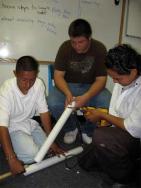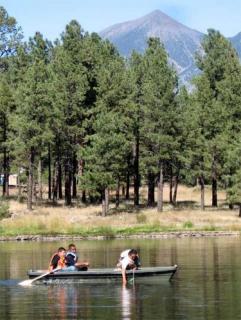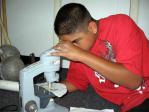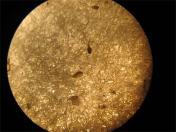Our pond science unit has been amazing, and the first phase is almost completed. We have measured the depth of the pond, and are in the process of converting all our figures to centimeters so that we can make a much reduced scale model. We do though love the scientific method for as we started working with the numbers it became apparent that the length of Francis Short Pond was not the 177 meters which we had recorded. Our pond is no football field, so back to the drawing board, or measuring board. **Construction Phase **

Uriel, Ricky, and Jesus in the construction of our sediment trap.
We are also proud to say that we not only designed and built a sediment trap, but have also completed our fall deployment. But let's back up...****
Deployment!

The purpose for our project (hypothesis) -Does sedimentation play an active role in the ecosystem of the pond? (measuring the depth of the pond) -What do freshwater sediments look like? -Would we only catch sediments or are other aquatic components liable to get caught in the trap? -Will sedimentation change seasonally?
The lab work continues! 
**Alex observing samples from sediment bottle #1**
Two of our observations to date include: -The highest concentration of sediments were found in the surface lawyer of water, a little over three meters from the bottom of the pond. (we have a few guesses why at this point) -There was aquatic life found in the middle layer, two meters from the bottom of the pond. We also found no other life in any of the other tubes.
**From microscope to digital camera! **

Right now we are beginning to scratch the surface of our studies; we also hope to compare our water analyses with that of our sediment samples and see if there is a correlation between, Ph, dissolved oxygen, nitrates, temperature and turbidity with the sediment samples we continue to collect.
Do you recognize these critters?
If you are interested in designing a sediment trap an excellent source of information can be found in: Handbook of Techniques for Aquatic Sediments SamplingSampling refers to the process of selecting units or portions of a larger group that will be studied in order to answer questions about the larger group. The units can be people, water samples, ice cores, or any other appropriate object. Participants will explore the meaning of sampling and how it impacts experimental design and explore factors that define and limit sampling in the variety of projects visited during the expedition. They will consider how results from the chosen samples are used to describe the bigger target of a project's study. By Alena Mudroch, Scott MacKnight
From 7000' Jillian's Class!
- < prev
- 44 of 44


Comments